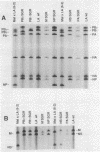Abstract
The transfer of six internal RNA segments from the avian influenza A/Mallard/New York/6750/78 (H2N2) virus reproducibly attenuates human influenza A viruses for squirrel monkeys and adult humans. To identify the avian influenza A virus genes that specify the attenuation and host range restriction of avian-human (ah) influenza A reassortant viruses (referred to as ah reassortants), we isolated six single-gene reassortant viruses (SGRs), each having a single internal RNA segment of the influenza A/Mallard/New York/6750/78 virus and seven RNA segments from the human influenza A/Los Angeles/2/87 (H3N2) wild-type virus. To assess the level of attenuation, we compared each SGR with the A/Los Angeles/2/87 wild-type virus and a 6-2 gene ah reassortant (having six internal RNA segments from the avian influenza A virus parent and two genes encoding the hemagglutinin and neuraminidase glycoproteins from the wild-type human influenza A virus) for the ability to replicate in seronegative squirrel monkeys and adult human volunteers. In monkeys and humans, replication of the 6-2 gene ah reassortant was highly restricted. In humans, the NS, M, PB2, and PB1 SGRs each replicated significantly less efficiently (P less than 0.05) than the wild-type human influenza A virus parent, suggesting that each of these genes contributes to the attenuation phenotype. In monkeys, only the NP, PB2, and possibly the M genes contributed to the attenuation phenotype. These discordant observations, particularly with regard to the NP SGR, indicate that not all genetic determinants of attenuation of influenza A viruses for humans can be identified during studies of SGRs conducted with monkeys. The PB2 and M SGRs that were attenuated in humans each exhibited a new phenotype that was not observed for either parental virus. Thus, it was not possible to determine whether avian influenza virus PB2 or M gene itself or a specific constellation of avian and human influenza A virus specified restriction of virus replication in humans.
Full text
PDF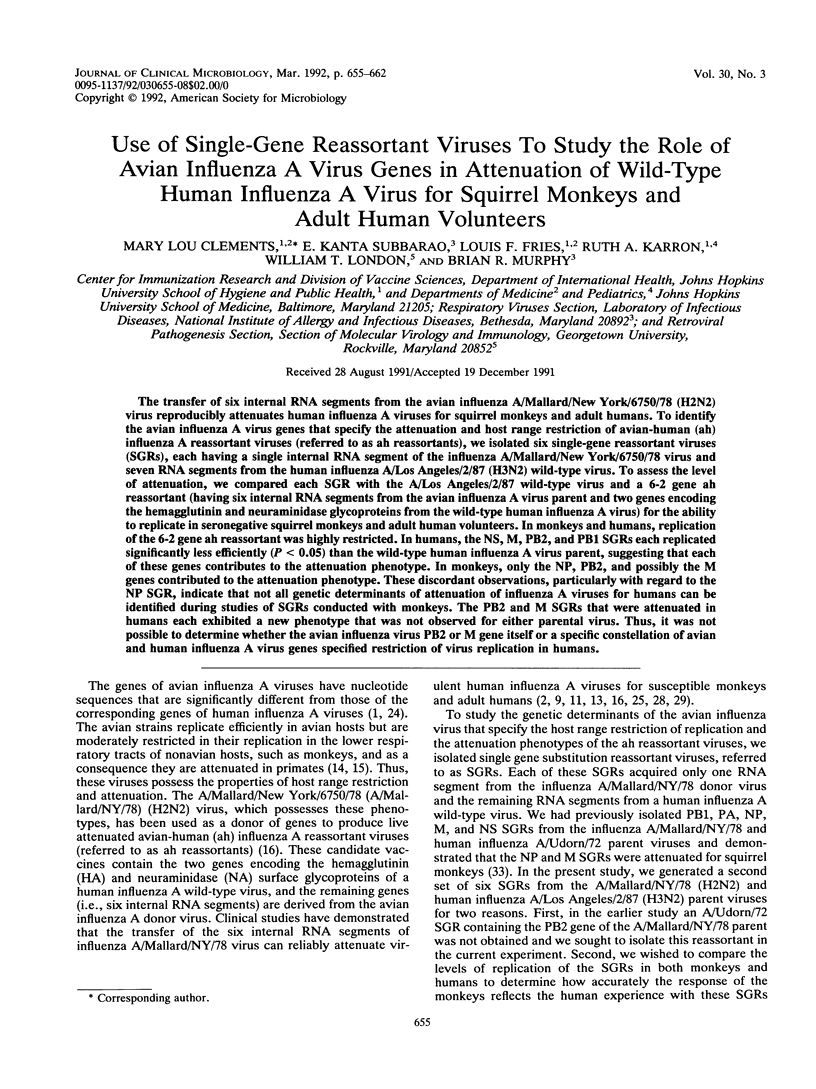
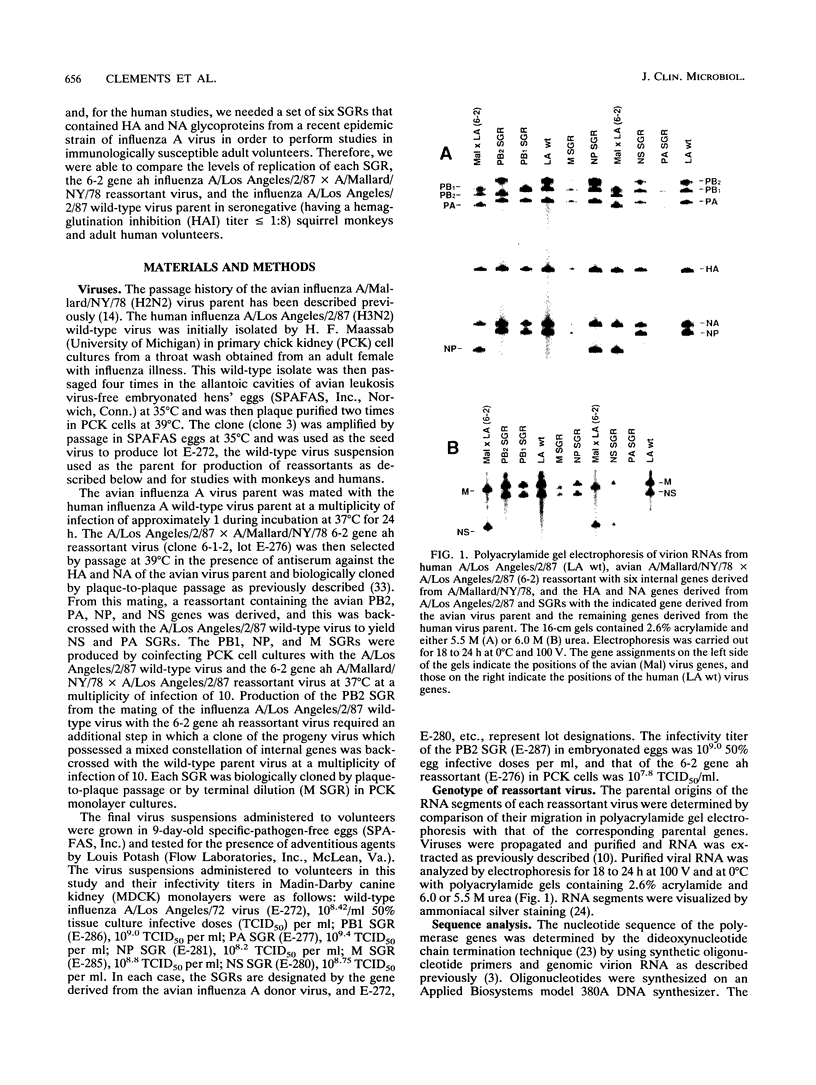
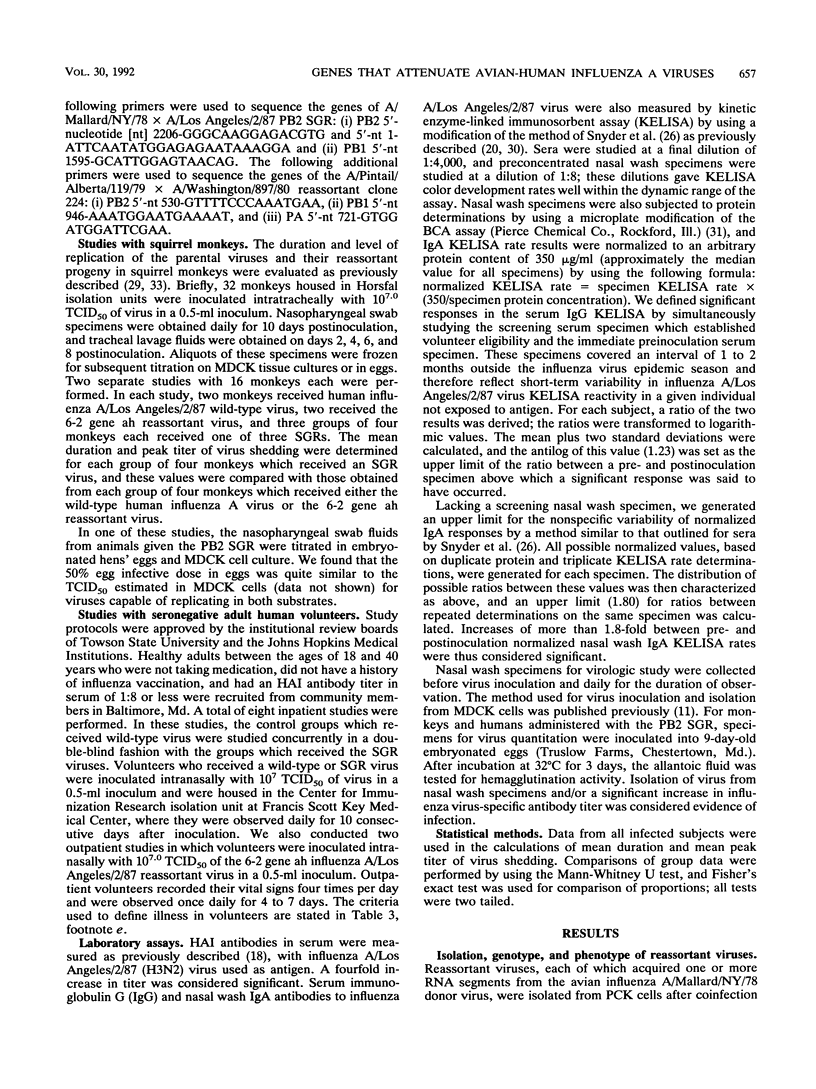
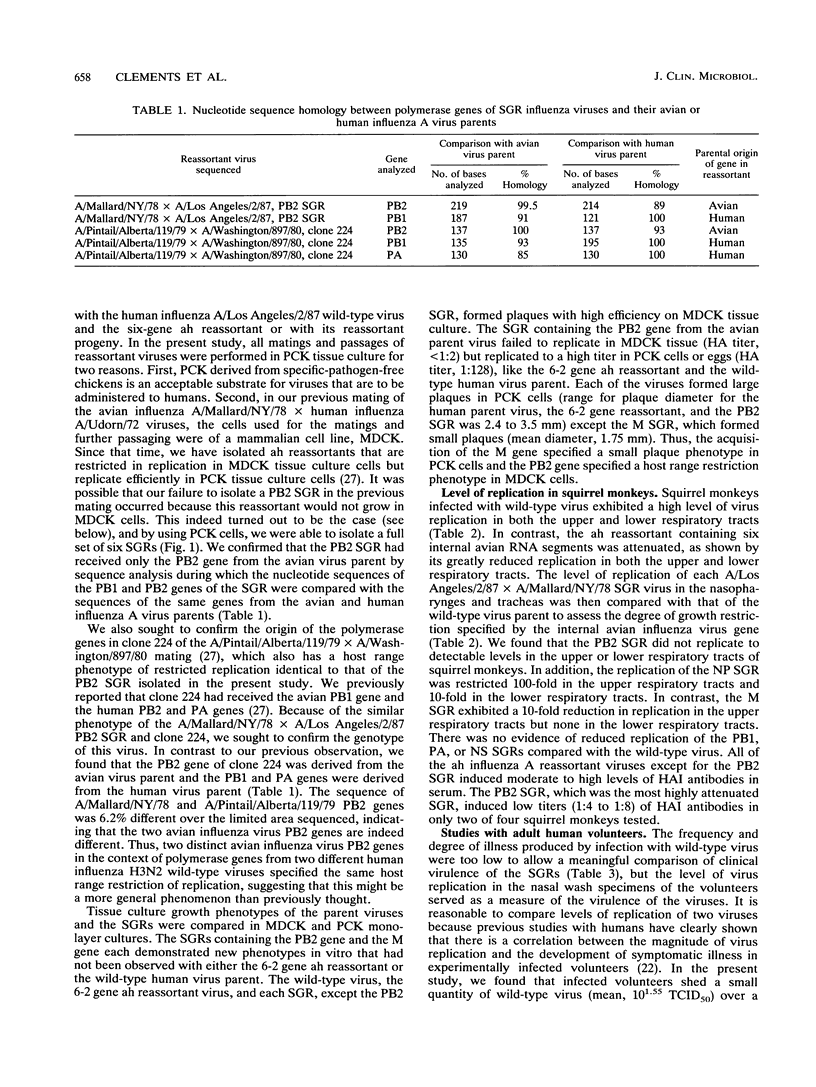
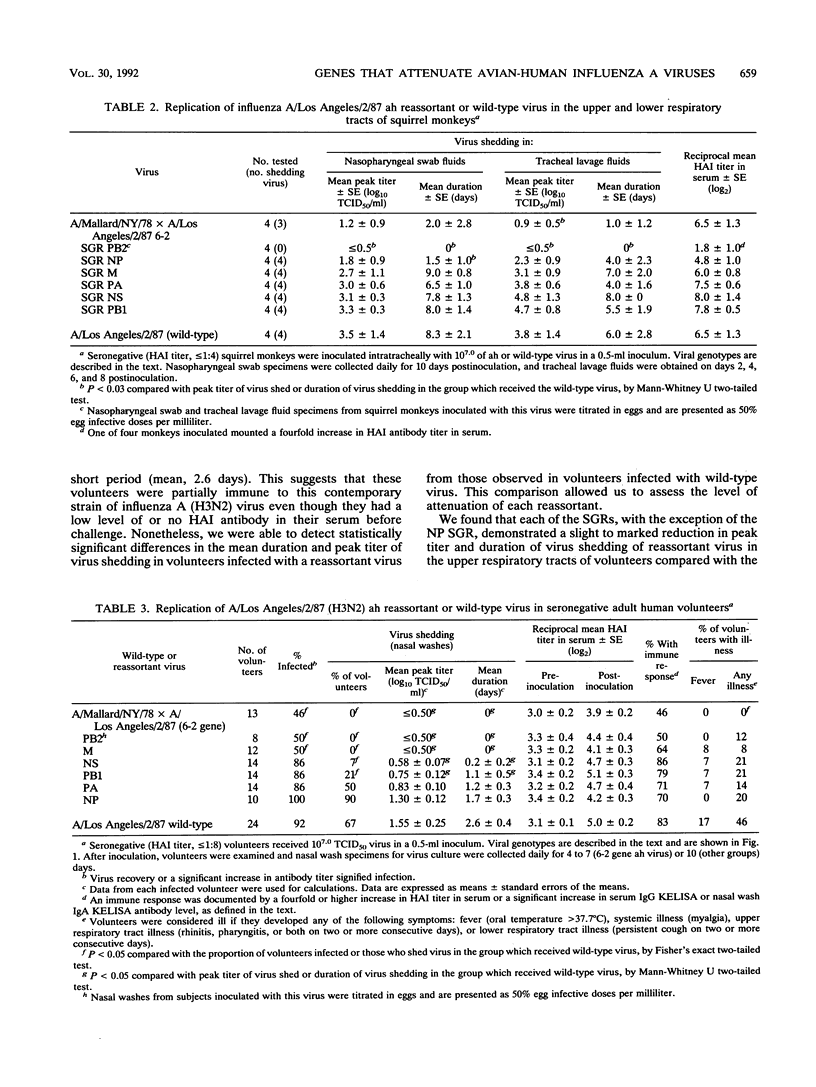
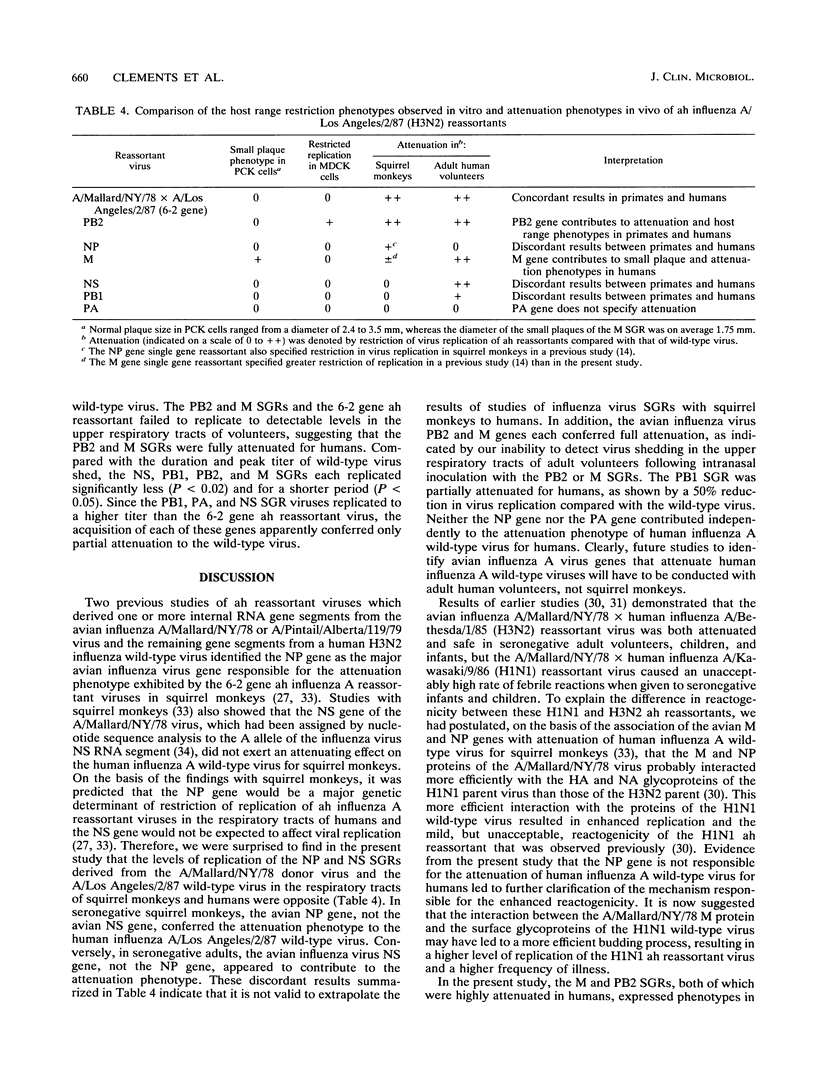
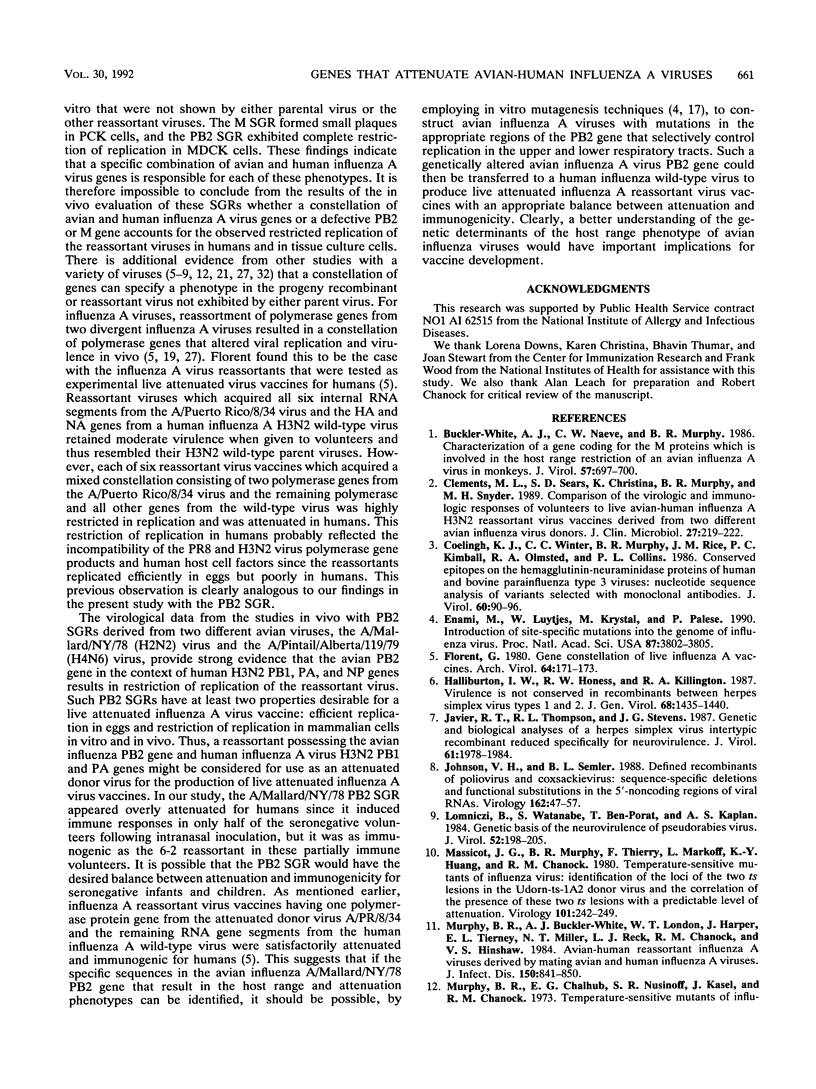
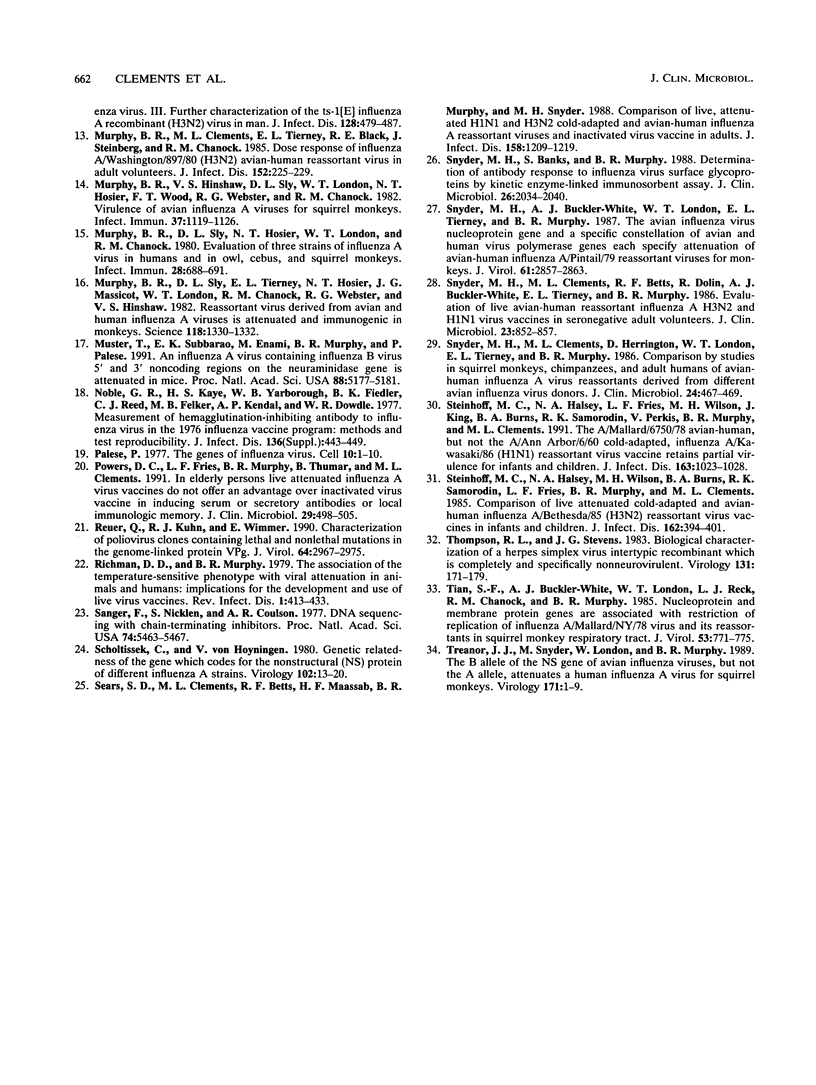
Images in this article
Selected References
These references are in PubMed. This may not be the complete list of references from this article.
- Buckler-White A. J., Naeve C. W., Murphy B. R. Characterization of a gene coding for M proteins which is involved in host range restriction of an avian influenza A virus in monkeys. J Virol. 1986 Feb;57(2):697–700. doi: 10.1128/jvi.57.2.697-700.1986. [DOI] [PMC free article] [PubMed] [Google Scholar]
- Clements M. L., Sears S. D., Christina K., Murphy B. R., Snyder M. H. Comparison of the virologic and immunologic responses of volunteers to live avian-human influenza A H3N2 reassortant virus vaccines derived from two different avian influenza virus donors. J Clin Microbiol. 1989 Jan;27(1):219–222. doi: 10.1128/jcm.27.1.219-222.1989. [DOI] [PMC free article] [PubMed] [Google Scholar]
- Coelingh K. J., Winter C. C., Murphy B. R., Rice J. M., Kimball P. C., Olmsted R. A., Collins P. L. Conserved epitopes on the hemagglutinin-neuraminidase proteins of human and bovine parainfluenza type 3 viruses: nucleotide sequence analysis of variants selected with monoclonal antibodies. J Virol. 1986 Oct;60(1):90–96. doi: 10.1128/jvi.60.1.90-96.1986. [DOI] [PMC free article] [PubMed] [Google Scholar]
- Enami M., Luytjes W., Krystal M., Palese P. Introduction of site-specific mutations into the genome of influenza virus. Proc Natl Acad Sci U S A. 1990 May;87(10):3802–3805. doi: 10.1073/pnas.87.10.3802. [DOI] [PMC free article] [PubMed] [Google Scholar]
- Florent G. Gene constellation of live influenza A vaccines. Arch Virol. 1980;64(2):171–173. doi: 10.1007/BF01318021. [DOI] [PubMed] [Google Scholar]
- Halliburton I. W., Honess R. W., Killington R. A. Virulence is not conserved in recombinants between herpes simplex virus types 1 and 2. J Gen Virol. 1987 May;68(Pt 5):1435–1440. doi: 10.1099/0022-1317-68-5-1435. [DOI] [PubMed] [Google Scholar]
- Javier R. T., Thompson R. L., Stevens J. G. Genetic and biological analyses of a herpes simplex virus intertypic recombinant reduced specifically for neurovirulence. J Virol. 1987 Jun;61(6):1978–1984. doi: 10.1128/jvi.61.6.1978-1984.1987. [DOI] [PMC free article] [PubMed] [Google Scholar]
- Johnson V. H., Semler B. L. Defined recombinants of poliovirus and coxsackievirus: sequence-specific deletions and functional substitutions in the 5'-noncoding regions of viral RNAs. Virology. 1988 Jan;162(1):47–57. doi: 10.1016/0042-6822(88)90393-5. [DOI] [PubMed] [Google Scholar]
- Lomniczi B., Watanabe S., Ben-Porat T., Kaplan A. S. Genetic basis of the neurovirulence of pseudorabies virus. J Virol. 1984 Oct;52(1):198–205. doi: 10.1128/jvi.52.1.198-205.1984. [DOI] [PMC free article] [PubMed] [Google Scholar]
- Massicot J. G., Murphy B. R., Thierry F., Markoff L., Huang K. Y., Chanock R. M. Temperature-sensitive mutants of influenza virus. Identification of the loci of the two ts lesions in the Udorn-ts-1A2 donor virus and the correlation of the presence of these two ts lesions with a predictable level of attenuation. Virology. 1980 Feb;101(1):242–249. doi: 10.1016/0042-6822(80)90499-7. [DOI] [PubMed] [Google Scholar]
- Murphy B. R., Buckler-White A. J., London W. T., Harper J., Tierney E. L., Miller N. T., Reck L. J., Chanock R. M., Hinshaw V. S. Avian-human reassortant influenza A viruses derived by mating avian and human influenza A viruses. J Infect Dis. 1984 Dec;150(6):841–850. doi: 10.1093/infdis/150.6.841. [DOI] [PubMed] [Google Scholar]
- Murphy B. R., Clements M. L., Tierney E. L., Black R. E., Stienberg J., Chanock R. M. Dose response of influenza A/Washington/897/80 (H3N2) avian-human reassortant virus in adult volunteers. J Infect Dis. 1985 Jul;152(1):225–229. doi: 10.1093/infdis/152.1.225. [DOI] [PubMed] [Google Scholar]
- Murphy B. R., Hinshaw V. S., Sly D. L., London W. T., Hosier N. T., Wood F. T., Webster R. G., Chanock R. M. Virulence of avian influenza A viruses for squirrel monkeys. Infect Immun. 1982 Sep;37(3):1119–1126. doi: 10.1128/iai.37.3.1119-1126.1982. [DOI] [PMC free article] [PubMed] [Google Scholar]
- Murphy B. R., Sly D. L., Hosier N. T., London W. T., Chanock R. M. Evaluation of three strains of influenza A virus in humans and in owl, cebus, and squirrel monkeys. Infect Immun. 1980 Jun;28(3):688–691. doi: 10.1128/iai.28.3.688-691.1980. [DOI] [PMC free article] [PubMed] [Google Scholar]
- Murphy B. R., Sly D. L., Tierney E. L., Hosier N. T., Massicot J. G., London W. T., Chanock R. M., Webster R. G., Hinshaw V. S. Reassortant virus derived from avian and human influenza A viruses is attenuated and immunogenic in monkeys. Science. 1982 Dec 24;218(4579):1330–1332. doi: 10.1126/science.6183749. [DOI] [PubMed] [Google Scholar]
- Muster T., Subbarao E. K., Enami M., Murphy B. R., Palese P. An influenza A virus containing influenza B virus 5' and 3' noncoding regions on the neuraminidase gene is attenuated in mice. Proc Natl Acad Sci U S A. 1991 Jun 15;88(12):5177–5181. doi: 10.1073/pnas.88.12.5177. [DOI] [PMC free article] [PubMed] [Google Scholar]
- Palese P. The genes of influenza virus. Cell. 1977 Jan;10(1):1–10. doi: 10.1016/0092-8674(77)90133-7. [DOI] [PubMed] [Google Scholar]
- Powers D. C., Fries L. F., Murphy B. R., Thumar B., Clements M. L. In elderly persons live attenuated influenza A virus vaccines do not offer an advantage over inactivated virus vaccine in inducing serum or secretory antibodies or local immunologic memory. J Clin Microbiol. 1991 Mar;29(3):498–505. doi: 10.1128/jcm.29.3.498-505.1991. [DOI] [PMC free article] [PubMed] [Google Scholar]
- Reuer Q., Kuhn R. J., Wimmer E. Characterization of poliovirus clones containing lethal and nonlethal mutations in the genome-linked protein VPg. J Virol. 1990 Jun;64(6):2967–2975. doi: 10.1128/jvi.64.6.2967-2975.1990. [DOI] [PMC free article] [PubMed] [Google Scholar]
- Richman D. D., Murphy B. R. The association of the temperature-sensitive phenotype with viral attenuation in animals and humans: implications for the development and use of live virus vaccines. Rev Infect Dis. 1979 May-Jun;1(3):413–433. doi: 10.1093/clinids/1.3.413. [DOI] [PubMed] [Google Scholar]
- Sanger F., Nicklen S., Coulson A. R. DNA sequencing with chain-terminating inhibitors. Proc Natl Acad Sci U S A. 1977 Dec;74(12):5463–5467. doi: 10.1073/pnas.74.12.5463. [DOI] [PMC free article] [PubMed] [Google Scholar]
- Scholtissek C., von Hoyningen-Huene V. Genetic relatedness of the gene which codes for the nonstructural (NS) protein of different influenza A strains. Virology. 1980 Apr 15;102(1):13–20. doi: 10.1016/0042-6822(80)90065-3. [DOI] [PubMed] [Google Scholar]
- Sears S. D., Clements M. L., Betts R. F., Maassab H. F., Murphy B. R., Snyder M. H. Comparison of live, attenuated H1N1 and H3N2 cold-adapted and avian-human influenza A reassortant viruses and inactivated virus vaccine in adults. J Infect Dis. 1988 Dec;158(6):1209–1219. doi: 10.1093/infdis/158.6.1209. [DOI] [PubMed] [Google Scholar]
- Snyder M. H., Banks S., Murphy B. R. Determination of antibody response to influenza virus surface glycoproteins by kinetic enzyme-linked immunosorbent assay. J Clin Microbiol. 1988 Oct;26(10):2034–2040. doi: 10.1128/jcm.26.10.2034-2040.1988. [DOI] [PMC free article] [PubMed] [Google Scholar]
- Snyder M. H., Buckler-White A. J., London W. T., Tierney E. L., Murphy B. R. The avian influenza virus nucleoprotein gene and a specific constellation of avian and human virus polymerase genes each specify attenuation of avian-human influenza A/Pintail/79 reassortant viruses for monkeys. J Virol. 1987 Sep;61(9):2857–2863. doi: 10.1128/jvi.61.9.2857-2863.1987. [DOI] [PMC free article] [PubMed] [Google Scholar]
- Snyder M. H., Clements M. L., Betts R. F., Dolin R., Buckler-White A. J., Tierney E. L., Murphy B. R. Evaluation of live avian-human reassortant influenza A H3N2 and H1N1 virus vaccines in seronegative adult volunteers. J Clin Microbiol. 1986 May;23(5):852–857. doi: 10.1128/jcm.23.5.852-857.1986. [DOI] [PMC free article] [PubMed] [Google Scholar]
- Snyder M. H., Clements M. L., Herrington D., London W. T., Tierney E. L., Murphy B. R. Comparison by studies in squirrel monkeys, chimpanzees, and adult humans of avian-human influenza A virus reassortants derived from different avian influenza virus donors. J Clin Microbiol. 1986 Sep;24(3):467–469. doi: 10.1128/jcm.24.3.467-469.1986. [DOI] [PMC free article] [PubMed] [Google Scholar]
- Steinhoff M. C., Halsey N. A., Fries L. F., Wilson M. H., King J., Burns B. A., Samorodin R. K., Perkis V., Murphy B. R., Clements M. L. The A/Mallard/6750/78 avian-human, but not the A/Ann Arbor/6/60 cold-adapted, influenza A/Kawasaki/86 (H1N1) reassortant virus vaccine retains partial virulence for infants and children. J Infect Dis. 1991 May;163(5):1023–1028. doi: 10.1093/infdis/163.5.1023. [DOI] [PubMed] [Google Scholar]
- Steinhoff M. C., Halsey N. A., Wilson M. H., Burns B. A., Samorodin R. K., Fries L. F., Murphy B. R., Clements M. L. Comparison of live attenuated cold-adapted and avian-human influenza A/Bethesda/85 (H3N2) reassortant virus vaccines in infants and children. J Infect Dis. 1990 Aug;162(2):394–401. doi: 10.1093/infdis/162.2.394. [DOI] [PubMed] [Google Scholar]
- Thompson R. L., Stevens J. G. Biological characterization of a herpes simplex virus intertypic recombinant which is completely and specifically non-neurovirulent. Virology. 1983 Nov;131(1):171–179. doi: 10.1016/0042-6822(83)90543-3. [DOI] [PubMed] [Google Scholar]
- Tian S. F., Buckler-White A. J., London W. T., Reck L. J., Chanock R. M., Murphy B. R. Nucleoprotein and membrane protein genes are associated with restriction of replication of influenza A/Mallard/NY/78 virus and its reassortants in squirrel monkey respiratory tract. J Virol. 1985 Mar;53(3):771–775. doi: 10.1128/jvi.53.3.771-775.1985. [DOI] [PMC free article] [PubMed] [Google Scholar]
- Treanor J. J., Snyder M. H., London W. T., Murphy B. R. The B allele of the NS gene of avian influenza viruses, but not the A allele, attenuates a human influenza A virus for squirrel monkeys. Virology. 1989 Jul;171(1):1–9. doi: 10.1016/0042-6822(89)90504-7. [DOI] [PubMed] [Google Scholar]



